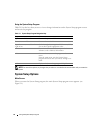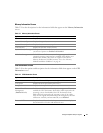
Using the System Setup Program 27
Memory Information Screen
Table 2-3 lists the descriptions for the information fields that appear on the Memory Information
screen.
CPU Information Screen
Table 2-4 lists the options and descriptions for the information fields that appear on the CPU
Information screen.
Table 2-3. Memory Information Screen
Option Description
System Memory Size Displays the amount of system memory.
System Memory Type Displays the type of system memory.
System Memory Speed Displays the system memory speed.
Video Memory Displays the amount of video memory.
System Memory Testing This option determines whether system memory tests are run at
system boot. Options are Enabled and Disabled.
Node Interleaving If this field is enabled, memory interleaving is supported if a
symmetric memory configuration is installed. If this field is set to
disabled (the default), the system can support Non-Uniform
Memory Architecture (NUMA) memory access. See "Memory
Module Installation Guidelines" on page 46.
Table 2-4. CPU Information Screen
Option Description
64-bit Specifies if the installed processor(s) support 64-bit extensions.
Core Speed Displays the clock speed of the processor(s).
Bus Speed Displays the bus speed of the processor(s).
Demand-Based Power
Management
(Disabled default)
Enables or disables demand-based power management. When
enabled, the CPU Performance State tables will be reported to the
operating system; when disabled, the CPU Performance State
tables will not be reported to the operating system. If any of the
CPUs do not support demand-based power management, the field
will become read-only, and automatically set to Disabled.
Processor X ID Displays the model number of the processor. A submenu displays
the amount of level 2 cache and number of cores.


















